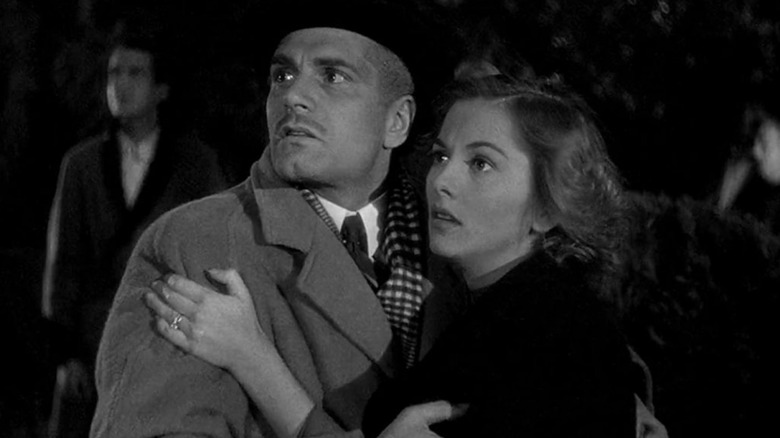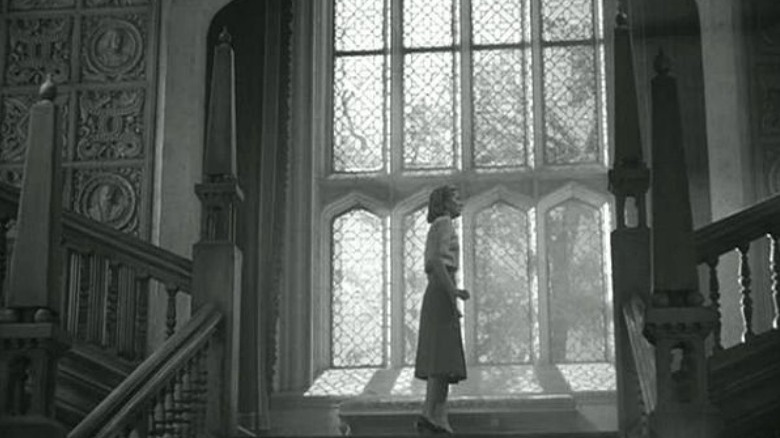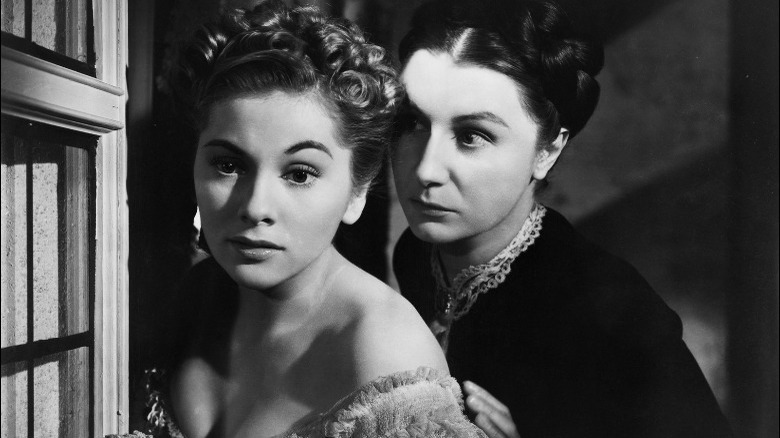How Alfred Hitchcock Subtly Makes You Feel Uneasy In Rebecca
Alfred Hitchcock wrote the book on making suspense come alive on-screen. During his decades-long career, the filmmaker directed over 50 features. Though he dabbled in many genres, his best films are regarded as cinema's most chilling classics. "Rebecca," the Master of Suspense's 1940 adaptation of Daphne du Maurier's Gothic novel, is one of his best.
In his early films, Hitchcock popularized filmmaking methods that would go on to become industry norms. Small but clever formal choices emphasized his characters' states of mind or revealed key information about the setting. In a 1972 interview for The Dick Cavett Show, the director explained a few of the simple ways he emphasized the story of the two Mrs. de Winters.
Distance makes the heart grow anxious
Hitchcock explained that he shot actress Joan Fontaine at a distance when her character first reaches the mysterious Manderley Estate after marrying Maxim de Winter (Laurence Olivier). The second Mrs. de Winter is dwarfed by the architecture in shots that communicate her isolation and psychological sense of unimportance in comparison to Rebecca. After all, the poor woman doesn't even get a first name, yet the specter of her husband's first wife looms large in the movie's title.
"The young girl there was brought to a big house, very scared," Hitchcock says when describing the scene to Cavett. "So, naturally, when she walks into this big room, you've made her small deliberately." This may seem like Filmmaking 101, but it's easy to forget that Hitchcock himself shaped movie directing as we know it. The director described the way loneliness can be conveyed by a long shot, telling Cavett that all one needs is "one figure alone in a room."
Hitchcock also explained that he deepened audiences' sense of unease by making Fontaine herself slightly uneasy. Hitchcock had a long history of making his lead actors miserable, culminating in the abuse allegations Tippi Hedren described in her memoirs. In his descriptions of "Rebecca," the director admitted to purposely making Fontaine feel uncomfortable — but in an extremely subtle way. "To make her feel afraid, I even had a fan blow her hair slightly," the director told Cavett. Fontaine's unease coupled with the eeriness of a wind that seemingly comes from nowhere plants a seed of suspense that grows throughout the movie.
The suspense just keeps building
"Rebecca" is a deeply subtle film. Its central antagonistic relationship between the second Mrs. de Winter and Judith Anderson's Mrs. Danvers is shot through with romantic tension, despite the film being made during a time when the Hays Code forbade depictions of homosexuality on-screen. Just as Hitchcock was able to manipulate audiences into feeling lonely alongside the second Mrs. de Winter, he was also able to sneak the film's queer undertones past the censors. The psychological thriller builds to a fever pitch, but in its early scenes, it lays the groundwork for its big reveals — and tense dynamics — with a number of simple but brilliant filmmaking flourishes.
The always self-assured filmmaker ends the Cavett interview with a dig at filming tricks that forgo realism for style. When the host mentions Westerns with shots from inside a fireplace or behind a cactus plant, the filmmaker shrugs them off as "ridiculous" and "quite silly" because they pull focus from characters and set up impossible perspectives. For Hitchcock, the camera is the eye, creating the story as it chooses what to look at and what to glance away from. In a film like "Rebecca," that strategy works perfectly, as we see the sinister love story among the residents of Manderlay play out with a sure cinematic focus that only adds to its ever-growing suspense.


